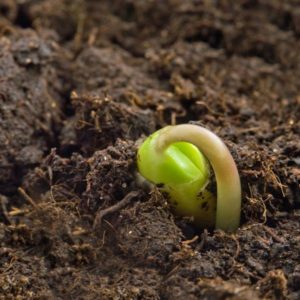HOW TO MAKE COMPOST: BLACK GOLD FOR YOUR OWN GARDENS!
 Feeding your lawn and gardens is an important part of plant health. Sure, you can go buy expensive fertilizers and apply them every so often, but did you know that you can make your own with very little effort? Store bought fertilizers are often synthetic nutrients designed to release the minerals needed for vegetation to thrive, but these nutrients are all naturally found in many of your yard and home wastes.
Feeding your lawn and gardens is an important part of plant health. Sure, you can go buy expensive fertilizers and apply them every so often, but did you know that you can make your own with very little effort? Store bought fertilizers are often synthetic nutrients designed to release the minerals needed for vegetation to thrive, but these nutrients are all naturally found in many of your yard and home wastes.
Composting is the practice of recycling all those organic wastes you accumulate into a homemade fertilizer you can use in a variety of ways. With multiple approaches to making your own, you can quickly begin creating your own ‘black gold’ to use to feed the vegetation on your property. If you need an excuse to get started, check out how to make compost below to create your own rich plant food for free.
WHAT IS COMPOST?
Compost is the result of microbial processes breaking down organic materials. Popular amongst gardeners who often have a lot of organic wastes, it has also become a common practice for those who are conscientious about their own environmental responsibilities and want to lower their carbon footprint.
We toss a surprisingly large amount of perfectly good organic substances every day. Even though they do eventually break down in landfills, they are commonly mixed with non-organic materials which slows down decomposition. With very little effort you can make your own compost to use, share, or simply let sit.
The result of composting yields a rich material that can be used, in part, as a natural fertilizer to feed your vegetation. Defined truly as a soil amender, it helps put vital nutrients back into the soil, helps retain moisture, and creates a healthier soil overall for plant growth and production.
COMPOST TYPES
Just like anything else, there is no one true way to get a composting end result, and you can easily decide which method is best for your own personal needs. Whether you want to just pile up your organic waste and let nature take its course, or regularly spend time turning and ‘cooking’ your compost- there is an approach that works with everyone’s effort level.
COLD COMPOSTING

The simplest method, this is the choice I regularly apply to my own busy life and am more than happy with the results. I also am going to focus on this technique throughout the article because it helps to explain the process of compost decomposition, as well as allows you to actually see the results of the layering that occurs.
Cold composting is just that: after your initial efforts all you need to do is start tossing your organic wastes onto the pile. After six months or so the bottom layers will begin to break down, making it surprisingly easy to take the compost from the bottom and allow the top most layers to shift downwards. It’s called cold because you aren’t monitoring the heat of your pile to speed up decomposition. Instead you are letting natural bacterial processes take place without interruption.
It does not require any fancy bin- and in fact I simply made a quick space out of wood pallets to help keep everything in one spot for easy access. You most likely will not have compost ready for use the first season you start your cold compost, but it will be ready by the following growing season. It’s best to start no later than early fall for next year’s use.
HOT COMPOSTING
Hot composting refers to the method that helps speed up the decomposition process. Again, you don’t need any fancy bins for this, but the more controlled the environment- the faster your compost will be ready for use. Also, keeping the pile at a manageable size makes it easier to control.
Many people prefer to use a compost tumbler for this approach as it makes turning the materials much simpler than using a shovel or pitchfork to regularly turn and mix you layers. You also need to monitor the temperature and moisture levels, keeping temps between 130 and 140 fahrenheit. The moisture content should also be damp, requiring you to regularly water the compost, usually at each turning. This helps keep microbial processes, which break down the materials you add into a rich compost, hard at work.
WORM COMPOSTING

Worm composting depends on worms to eat their way through decomposing materials, after which they excrete rich castings. Also called vermicompost, you will want to do this in a controlled environment. You can easily purchase or make your own layered worm composter that applies a cold composting method of putting new materials on top after initially creating a hospitable environment for your worms to begin their work.
This is a great way to compost if you are limited on space, or even if you are an apartment dweller and simply want to decent soils for potted plants.
COMPOSTING MATERIALS
Although much of what we toss can be composted, not everything can. Although the following lists are not a complete list, it covers a lot of everyday materials you might be tossing, and gives you a heads up of what to avoid.
Overall you need to have a decent ratio of carbon rich to nitrogen rich materials to get started with any type of composting approach you decide upon. These are also called brown and green materials and should be roughly applied at a 25 (nitrogen) to 1 (carbon) ratio to influence decomposition and microbial activity.
WHAT YOU CAN COMPOST
The following list may be incomplete but allow you an excellent idea of what types of materials are considered brown and green. Once you have a good foundation you can begin to layer your materials as they become available, although it is a good idea to keep this ratio in mind. Always try and shred or rip up larger materials to allow it to break down more quickly.
CARBON RICH (BROWN MATERIALS)

Carbon rich materials include things like:
- Cardboard
- Newspaper
- Straw
- Dead and dried plant materials
- Burlap
- Tissues and napkins
- Hair (have a shedding pet?)
- Pine needles
- Paper plates
- Natural fibers such as cotton and leather
- Lint from a dryer
- Dead leaves
- Wood chips, small twigs, wood shavings
- Bread
- Ash from firewood
NITROGEN RICH (GREEN MATERIALS)

Nitrogen rich, or green materials, are called such because they are quite ‘green’ and fresh compared to brown materials. These include:
- Pulled weeds that have not seeded
- Vegetables and fruit that is rotted, freezer burned, or being discarded
- Fresh grass clippings
- Coffee grounds
- Urine
- Animal manure (avoid cat and dog waste)
- Tea bags
- Eggshells
WHAT YOU SHOULDN’T COMPOST
Certain wastes should not be used in compost as it will not break down or will disrupt the natural processes. Pay attention to the following to avoid adding it to your compost pile or bin. Also avoid those items that may have come in contact with any of the following:
- Cooking oils and grease
- Seeded weeds or diseases plants
- Styrofoam
- Sawdust or chips from treated woods
- Plastic coated or glossy papers
- Glass
- Coal ash
- Dairy and meat products (may be composted but also likely to draw in rodents. Bury in the middle of your pile to avoid problems if you want to compost it)
STEPS TO CREATING YOUR OWN COMPOST

Obviously, the true first step is to determine where you want your compost to be located. Even if you have a nice portable tumbler, they can get rather heavy once loaded up. Because I am a fan of the cold composting method that lets me basically forget about it until I need it, mine is located towards the edge of my property where I can get to it when I want to, but otherwise it isn’t really noticeable.
Some people like to put up a fence around their own homemade options, or simple go for a commercial answer that keeps things nice and tidy and available for use. Keep in mind that placing it in full sun will help with the overall breakdown of the materials.
STEP 1: CREATE YOUR FOUNDATION
No matter which method you choose, if you are serious about composting you want to at least take the time to create a good foundation. Depending on the size of your bin (for simplicity’s sake, let’s assume you have a 4 x 4 foot space) you want to have approximately 3 feet of material to get started.
This base should be a good mix (NOT layered) of your 25 brown to 1 green ratio. This will provide the materials you need for proper oxygenation to help kickstart decomposition. Once you have this started you might want to cover it with a layer of brown materials, such as grass clippings, to provide a sort of insulation that will keep it from drying out too quickly. The layers you add after this will continue to provide this protection and work downwards as decay begins.
Hint: Mix in a few shovelfuls of your own existing soils as well. This often already has a healthy microbial community that will work towards getting your own compost started.
STEP 2: WATER YOUR PILE

When you first get started water your pile well. Give it a good soaking as long as long as you know the water will drain out the bottom (you don’t want it to sit in water as that will inhibit oxygenation). This will kickstart microbial activity as your pile begins to warm up through the breakdown of organic materials. Once decomposition begins and microbes are active they support themselves very well.
Hint: It never hurts to water your pile as you pass by, even if you are a cold method. Just be sure to never have more water than what a wrung out sponge might feel like.
STEP 3: WAIT, OR MONITOR AND TURN AND HYDRATE

Cold composters, you need to wait. As mentioned you don’t really want to start your pile any later than early autumn if you want to take advantage of it by the next planting season. Ideally you may need to give it a year. A lot of this depends on your climate as well. Wet, rainy and humid areas will allow for faster decomposition than very dry climates with longer winters. The good thing is, once you have a layer ready to use you are on your way to a continual source as long as you have been regularly ‘feeding’ the pile.
If you are hot composting then you are going to be turning your pile every few days as the temperature of your center fall below 130 degrees (see why a tumbler comes in handy?). You also need to monitor the moisture to make sure it stays damp. The flip side of all this work? You will have compost ready to use in a fairly quick amount of time (1 to 3 months depending on the size of the pile).
Hint: Once you choose a method, stick to it. Turning a cold compost a few months after it begins will interrupt what is going on there, and possibly force the whole process to have to start all over again, or stop it altogether during the colder, winter months. Composts will continue to breakdown through the winter due to the heat generated in the middle of the pile.
STEP 4: WAYS TO APPLY COMPOST

Compost can be used in a variety of ways, and once your organic materials have transformed into ‘black gold’ you are ready to apply it. Curious to know when is it ready? The consistency should be dark brown in color and crumbly in consistency. It should never smell bad, and instead have a rich, earthy aroma to it.
Many people prefer to work compost into their garden soils prior to planting each year to help amend the feel and replace lost nutrients through the growing season. It also can be easily raked into the topsoil is needed to help boost plant health and production.
If you don’t feel like doing much work, simply spread it over the top of your existing soils or grasses. Watering and regular process will allow it to continue to breakdown and release into the soil beneath it. You also can place a shovelful in a 5 gallon bucket and allow it to soak in water. After a few days you have a rich compost tea that you can use to water potted plants, soak your grasses with, or direct to specific plants you feel would benefit from its rich moisture. This ‘tea’ gets nutrients directly to the roots in a very quick manner.
Hint: Even if you have larger pieces of compost mixed into the finished product, still use it since certain things may not break down quite as quickly- such as twigs or cloth. They WILL continue to decompose wherever you use your compost and provide nutrients to the soil.
CONCLUSION
The methods applied here will help you be successful in making your own compost pile. No matter what you choose to do, keep in mind that a proper foundation is a great way to get started in supplying your own endless supply of compost to use for soil amendment and vegetative support. Many, many things can be composted, and as long as you avoid the ‘do not compost’ list, you should have a healthy pile of refuse for microorganisms to make their home in.


